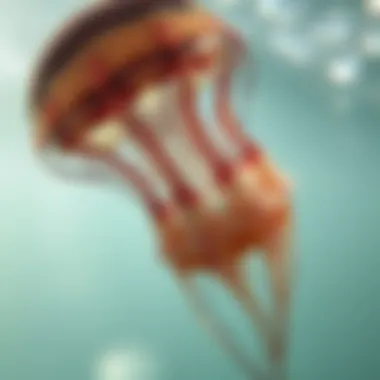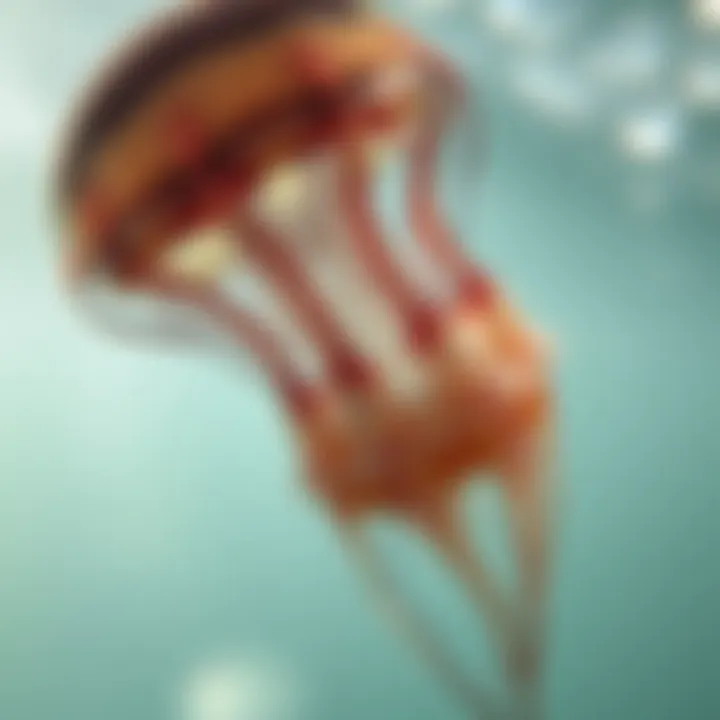Understanding Jellyfish Burns and Their Impact on Surfers


Intro
Surfing is a thrilling experience filled with the joy of catching waves, feeling the ocean's power, and bathing in the sun's warm embrace. Yet, not all of these outings go as smoothly as one might hope; jellyfish stings can turn a beautiful day at the beach into an unpleasant ordeal. Understanding jellyfish burns and their implications is crucial for surfers and beachgoers. Not only do these stings cause discomfort, but the risks associated can affect your surfing enjoyment and safety.
In this article, we will explore the various species of jellyfish that pose a threat, the physiological effects of their stings, and practical ways to prevent and treat jellyfish injuries. Armed with this knowledge, surfers can make informed decisions when hitting the waves and enjoy a safer ocean experience.
Gear and Equipment
When preparing for a day of surfing, having the right gear is paramount, but it's not all about boards and wetsuits. In the context of jellyfish hazards, there are additional considerations to touch upon. Making safety a priority can minimize encounters and manage risks effectively.
Latest Surfboard Technologies
Modern surfboards come outfitted with numerous technologies designed for performance and safety. Materials such as epoxy and carbon fiber make boards lighter and stronger. However, many surfers might overlook essential features that enhance their overall experience when facing hazardous marine life.
Experience shows that the construction of your surfboard can affect how you react to jellyfish encounters. For instance, board designs that include more buoyancy may keep surfers farther from the water's surface, giving them more time to evade these creatures. Choosing a board with a flatter tail can also improve maneuverability, allowing you to dodge unexpected jellyfish in your path.
Essential Accessories for Every Surfer
Beyond the surfboard itself, there are several accessories that surfers should consider:
- Protective Rash Guards: Wearing long-sleeved rash guards creates a barrier against stings. Materials designed to wick away moisture help to maintain comfort during hot days.
- Wetsuits with Protective Linings: Some work better than others when it comes to shielding skin from stings. Look for wetsuits that focus on protective technology in specific areas, like chest or legs.
- Post-Surf Treatments: Surfing first aid kits should always include vinegar or baking soda, which help neutralize the pain of jellyfish stings. Keeping a compact treatment plan handy helps when those unexpected encounters happen.
Surfers often focus on performance accessories, but safety should never take a backseat. The right gear can be the difference between a perfect wave and a painful sting.
Surf Techniques and Skills
Equipping yourself with knowledge isn't just about the gear; it also involves mastering water skills that can keep jellyfish encounters to a minimum.
Beginner Surfing Techniques
New surfers might feel a bit overwhelmed at first, and rightly so. Mastering basic techniques—like balancing, paddling, and understanding currents—can help prevent bumps into jellyfish zones. Here are a few tips for beginners:
- Stay close to the shore where the waters are more manageable. Many dangerous jellyfish species prefer deeper waters.
- Observe the conditions before you hit the water. Local surf reports often mention jellyfish sightings or stinging incidents.
Advanced Maneuvers for Experienced Surfers
Veterans in the water can apply a few strategies to minimize the risk of jellyfish encounters:
- Evasive Surfing: Skills such as rapid paddling or maneuvering around visible jellyfish can be honed through practice. The quicker you can navigate, the less likely the chance of a sting.
- Awareness of Patterns: Experienced surfers can often read the ocean, recognizing where jellyfish tend to populate based on currents and wind patterns. Familiarity with local conditions can augment surf safety significantly.
Being prepared is invaluable. Reducing encounters with jellyfish gives surfers more freedom to enjoy their time catching waves without unnecessary worry. Understanding how to navigate potential risks is critical, and this article aims to arm you with the necessary knowledge and resources.
"The ocean stirs the heart, inspires the imagination, and brings eternal joy to the soul."
- Wyland
Prelude to Jellyfish and Their Natural Habitat
Jellyfish are among the most fascinating and yet misunderstood organisms in our oceans. Their squishy, translucent bodies float effortlessly through the water, serving as a reminder of the delicate balance that is required to maintain marine ecosystems. Understanding jellyfish and their natural habitat is essential, especially for surfers who frequently encounter these creatures while riding the waves. Knowledge of jellyfish can make a significant difference in how surfers navigate the waters, avoiding painful encounters and understanding the broader implications these creatures hold for marine health and surfing safety.
Defining Jellyfish
Jellyfish are not fish at all. Instead, they belong to the phylum Cnidaria, which also includes sea anemones and corals. Classified as gelatinous zooplankton, they possess a simple body structure made primarily of a soft, jelly-like substance, known scientifically as mesoglea. They lack a brain, heart, and bones, functioning instead with a basic nerve net that governs their swimming and feeding patterns. Jellyfish have been around for millions of years, likely evolving in tandem with various marine species and conditions. Their ability to survive in diverse marine environments speaks to their adaptability.
In more pragmatic terms, jellyfish can manifest in a range of sizes—from the tiny, almost invisible varieties to immense species that can span several feet across. This diversity is pivotal for surfers, as knowing the defining characteristics of different species can aid in both identification and risk assessment.
Ecosystems and Distribution
Jellyfish inhabit waters across the globe, from coastal regions to the depths of the open ocean. Their omnipresence can be attributed to their reproductive success and resilience to changing environmental conditions. They thrive in various habitats including estuaries, open seas, and even some freshwater systems. Understanding their distribution is crucial for surfers.
Surfers might encounter jellyfish most often in areas with high nutrient concentrations, such as coastal upwelling zones or near river mouths where organic matter pools for growth. Furthermore, seasonal factors can influence jellyfish population blooms. For instance, certain species flourish during warmer months when ocean temperatures rise, increasing the likelihood of encounters.
Key Considerations:
- Adaptability: Jellyfish species have shown adaptability to various habitats, thriving in both nutrient-rich and low-oxygen environments.
- Reproductive Patterns: Their reproductive strategies can lead to sudden population explosions, becoming a danger for those unaware.
- Climate Influence: Changes in underwater temperature and salinity due to climate change could impact jellyfish distributions and behavior.
The Anatomy of Jellyfish
Understanding the anatomy of jellyfish is fundamental for surfers and beach enthusiasts. These seemingly simple creatures hold complex biological structures that play a significant role in their ecology and interaction with humans. Knowing what makes up a jellyfish, particularly its stinging cells and other functional components, is vital for surfers aiming to avoid injuries and appreciate the ocean life around them.
Structure and Function
Jellyfish possess a unique body plan that differentiates them from many other marine species. They don't have brains, bones, or even hearts. Instead, they feature a gelatinous umbrella-shaped bell that is often translucent, which allows light to filter through, giving them a ghostly appearance in the water. Beneath this bell lies the oral arms and tentacles, which are pivotal for both movement and feeding.
Their buoyancy is fascinating. Jellyfish maintain their position in the water without much effort, providing them the ability to drift and absorb nutrients from their surroundings. The contraction of the bell allows for propulsion, pushing water behind them, which aids in their movement. They primarily float along the currents, searching out plankton and small fish.
An interesting aspect is their biological composition: the jellyfish’s body is about 95% water. This high water content not only aids in their buoyancy but also insulates them against temperature changes in the ocean. Surfers may notice their presence more during certain times of the year based on environmental changes that influence jellyfish population cycles.
The Role of Stinging Cells


The stinging cells of jellyfish, called nematocysts, are essential for their survival. These cells are what make jellyfish notorious in the surfing community. Upon contact, nematocysts can fire tiny barbed darts that inject venom into potential threats, whether it be predators or unsuspecting human swimmers.
Nematocysts Explained
Nematocysts are a remarkable adaptation unique to cnidarians. They resemble small capsules that contain tightly coiled, barbed threads. When a jellyfish is approached or disturbed, specialized cells called cnidocytes trigger the nematocysts to explode outward. This rapid deployment is not only a means of defense but also serves as a hunting mechanism. The venom delivered can incapacitate prey, allowing the jellyfish to consume it more easily.
One key characteristic that stands out about nematocysts is their specificity. Different species of jellyfish possess different types of nematocysts, with varying levels of toxicity. For example, the box jellyfish is known for its potent venom, capable of causing severe physiological reactions in humans. This highlights the importance of recognizing jellyfish species, especially for surfers who frequent the same waters.
Important Note: Nematocysts can remain functional even after the jellyfish is deceased, meaning that beachgoers should always exercise caution even when jellyfish are washed ashore.
The advantages of understanding nematocysts lie not just in preventing pain but also in appreciating the ecological role these creatures play. By knowing about their stinging mechanism, surfers can enhance their awareness of the underwater environment and take precautions to ensure their safety.
Types of Jellyfish That Cause Burns
Understanding the types of jellyfish that can inflict burns is crucial for anyone enjoying the ocean, especially surfers. Knowledge of these species can mean the difference between a day of fun and a painful medical emergency. By recognizing the characteristics of these jellyfish, surfers can take precautionary measures, reducing the risk of serious injury. This section will delve into the jellyfish commonly encountered in surf spots and how they pose a threat, ensuring that readers are well-informed.
Common Species Encountered by Surfers
Surfers tend to frequent waters where jellyfish are often found. Familiarity with the common species can help them spot dangers early and avoid unfortunate encounters.
Box Jellyfish Characteristics
The Box Jellyfish is often considered one of the most dangerous jellyfish in the world. This species is primarily known for its cube-shaped bell, which can be as large as 30 centimeters. Their tentacles can reach up to 3 meters long, trailing behind them as they swim. Their venom is extremely potent and can lead to severe pain, heart failure, or even death in extreme cases. What makes Box Jellyfish particularly dangerous is their affinity for warm coastal waters, which overlap with popular surfing areas.
- Key Characteristic: The highly toxic venom can immobilize prey rapidly.
- Unique Feature: They can actively swim against currents, increasing their chances of encountering surfers.
- Implications: This makes understanding the Box Jellyfish vital to avoiding serious injures as surfers could easily surf right into their lurking spots.
Moon Jellyfish Overview
Compared to the Box Jellyfish, the Moon Jellyfish appears more benign. Recognizable for its translucent, umbrella-like bell that can span up to 40 centimeters, this species tends to have four distinct horseshoe-shaped gonads visible through its bell. While their sting is typically mild and often only causes minor irritations, surfers should remain cautious.
- Key Characteristic: It’s a common sight along many coastlines, which means there's a higher probability of encounters.
- Unique Feature: The sting may surprise some due to its deceptively gentle nature, but even minor reactions can cause discomfort.
- Implications: Knowing how to identify the Moon Jellyfish can alleviate some fears about jellyfish stings since many surfers brush it off as harmless.
Portuguese Man O' War Insights
Often mistaken for a jellyfish, the Portuguese Man O' War is actually a colonial organism made up of several polyps functioning together. Its appearance with a striking blue and pink sail can be mesmerizing, but its long tentacles can deliver an intense sting. Found primarily in warm waters, this Marine creature trends towards beaches during warm weather, making them particularly relevant to surfers.
- Key Characteristic: The long tentacles can extend up to 30 meters, trailing behind its sail while drifting on the water’s surface.
- Unique Feature: Unlike many jellyfish, Portuguese Man O' War are not typically swimmers but are carried by ocean currents.
- Implications: Knowing the beautiful yet dangerous nature of this organism can help surfers recognize it quickly and avoid dangerous encounters.
Geographical Distribution of Threatening Species
The distribution of jellyfish species varies widely. Regions with warmer waters often see a higher density of potentially harmful species. Surfers should pay attention to local reports and advisories while planning their surfing trips. Some locations are notorious for jellyfish blooms, driven by environmental factors such as climate change and pollution. Identifying these patterns can be the key to enjoying the surf safely.
For further clarification on jellyfish safety protocols and to keep abreast of any regional jellyfish presence, surfing communities and local marine biology sites can be valuable resources. You can visit NOAA or check out Eastern Florida State College for marine biology insights.
Physiological Effects of Jellyfish Stings
When surfers hit the waves, they often encounter jellyfish without expecting it. This section dives into the physical reactions surfers might experience if stung, as understanding these reactions is crucial for being prepared and getting back to the surf quickly. It's not just about knowing what kind of jellyfish are in the area; it’s about how their stings can affect the body and what surfers can do about it. Knowledge here could mean the difference between enjoying a day at the beach or suffering significant discomfort.
Types of Reactions
Mild Reactions
Mild reactions from jellyfish stings can be bothersome but are often manageable. Common symptoms include localized redness, itching, and mild burning sensation at the spot of the sting. These reactions usually occur when a surfer is lightly grazed by tentacles from a less dangerous jellyfish, such as the Moon Jellyfish.
The beauty of mild reactions lies in their transient nature. Typically, these symptoms fade within a few hours, allowing surfers to resume their fun without too much disruption. The significance of mild reactions in our discussion is tied to their frequency; most surfers who encounter jellyfish often experience only mild reactions. Therefore, while they still merit attention and caution, they rarely indicate a serious threat.
One unique feature of mild reactions is that they can sometimes stem from a poor identification of jellyfish species. Surfers could attribute discomfort to jellyfish stings without realizing that other environmental factors—like stinging sea anemones—might be at play. Keeping awareness about the jellyfish present, alongside awareness of others in the water, can be advantageous for surfers.
Severe Reactions
In sharp contrast, severe reactions demand immediate attention. Although they are less common, the consequences can be dire for the surfer. Severe stings from Box Jellyfish, for example, can lead to intense pain, swelling, and in some cases, even systemic symptoms such as difficulty breathing or loss of consciousness. This type of reaction can be life-threatening, which heightens the need for surfers to recognize the signs early.
The hallmark of these reactions lies in their sudden onset and the urgency they require. This makes understanding severe reactions pivotal for surfers at risk of coming into contact with more dangerous species.
A unique aspect of severe reactions is their likelihood of causing long-term implications as well. Here, the psychological impact can weigh heavily on surfers, as experiencing a serious jellyfish sting could lead to an aversion to surfing altogether.
Long-Term Effects and Implications
The long-term effects of jellyfish stings can extend far beyond immediate physical reactions. Repeated exposure to jellyfish stings may lead some surfers to develop chronic pain or sensitivity at the sting site. Those who have had severe reactions may also be more prone to anxiety or fear when surfing in areas known for jellyfish presence. The emotional toll can greatly affect one’s enjoyment of surfing, leading to avoidance of particular spots or even a total withdrawal from the activity.
Moreover, jellyfish stings can result in significant healthcare costs. Surfers who experience severe reactions may find themselves facing not just the physical healing process, but also the can burden healthcare systems, especially in regions where police (or other emergency services) are involved in rescue operations.
In summary, understanding both mild and severe physiological reactions to jellyfish stings is essential for surfers aiming to minimize risks associated with this natural hazard. Immediate and long-term implications demand attention to help surfers navigate their experiences with jellyfish stings efficiently.
Safety Measures for Surfers
When surfers venture into the ocean, the thrill of riding waves can quickly turn into a perilous situation if jellyfish are lurking. Understanding safety measures is crucial, not just to avoid painful stings, but also to enhance the overall surfing experience. Knowledge is a surfer's best asset, as it can empower individuals to make informed decisions when in the water.
Recognizing where jellyfish are likely to inhabit can help mitigate the risk of encounters. Proactive engagement with local surf communities can also yield priceless insights, as seasoned surfers often share tips on recent jellyfish sightings and behavior patterns. By being aware of the conditions that foster jellyfish activity, surfers can choose their surfing times and locations with significantly improved confidence.


> "An ounce of prevention is worth a pound of cure."
Identifying Risky Areas
Identifying areas prone to jellyfish swarms is not just smart; it’s essential. Certain beaches are notorious for jellyfish outbreaks, often influenced by marine conditions such as temperature, currents, and even tides. As a surfer, it’s wise to consult local reports before hitting the waves.
- Look for beach notifications: Many coastal areas post warnings about jellyfish sightings. Don’t overlook these signs— they can save you a significant amount of discomfort.
- Check tide patterns: Some studies point to jellyfish being more present during specific tidal movements. Knowing when tides change could help you time your surf sessions accordingly.
- Join local surfing forums: Websites like Reddit might have threads alerting surfers about recent jellyfish activity.
Managing risks extends to recognizing potential dangers not just in the water but also near the shoreline. Practicing vigilance should be a habit for surfers who want to stay safe and focused on the ride.
Protective Gear Recommendations
When it comes to gear, prevention is better than cure. While no equipment can completely eliminate the risk of jellyfish stings, certain items can lessen the likelihood of contact.
Jellyfish Nets
Jellyfish nets make for an intriguing solution in surf gear. These nets are designed to be used in challenging areas, offering a physical barrier against jellyfish.
- Key characteristic: Jellyfish nets are typically made from fine mesh, ideal for allowing water to flow while significantly reducing contact with jellyfish tentacles.
- Why it’s beneficial: Using a jellyfish net can provide peace of mind, particularly in areas known for jellyfish clusters. Surfers can focus on catching waves instead of fretting over potential stings.
- Advantages: They are lightweight and portable. These nets don’t hinder mobility, allowing surfers to paddle around without feeling restricted.
- Disadvantages: However, they might not cover larger areas unless multiple nets are employed, which can be cumbersome.
Wetsuits as Protection
Wetsuits serve another worthy peer in protective gear. They are tailored to insulate and protect surfers, but their potential in jellyfish stings is often underappreciated.
- Key characteristic: A quality wetsuit covers most of the skin, offering a barrier between the jellyfish nematocysts and the surfer's body.
- Why it’s beneficial: They not only keep surfers warm but also protect against stings during long sessions, making them a prudent choice for avid surfers.
- Unique feature: Many wetsuits come with reinforced areas on the chest and arms, where stings are more common. This built-in reinforcement can be an important asset.
- Advantages: While they provide good protection against jellyfish stings, they also offer thermal insulation, which is crucial for colder water.
- Disadvantages: However, wearing one can be restrictive in hotter weather, and they are not a foolproof solution against all jellyfish types.
Ultimately, the right measures can create a safer surfing environment by reducing potential interactions with jellyfish, allowing surfers to enjoy their time in the water.
Immediate Treatment for Jellyfish Burns
Jellyfish burns can range from mild discomfort to intense pain. Understanding how to address these injuries immediately is crucial for anyone who spends time in the water, especially surfers. Immediate treatment can minimize the pain and reduce long-term complications. When faced with such a sting, knowing the right steps can mean the difference between suffering and relief.
First Aid Steps
Removal of Tentacles
One of the first actions to take when someone is stung by a jellyfish is to remove any tentacles that may be stuck to the skin. This step is essential because any remaining tentacle can continue to release venom, which intensifies the pain and irritation.
The notable characteristic of this step is the manner of removal. Use a pair of tweezers or the edge of a credit card to gently scrape off the tentacles. This method is popular due to its efficacy and safety; it reduces the risk of further injecting venom compared to using your fingers.
However, care must be taken not to pinch any remaining tentacle, as it may still contain active nematocysts. One unique advantage of this method is that it can be performed quickly, ideally within minutes of the sting, thereby mitigating further damage. On the downside, if done improperly, it could leave behind broken pieces of tentacle, exacerbating the issue.
Cooling the Burn
After tentacles have been removed, cooling the burn is the next recommended step. This approach is vital as it helps manage pain and reduces inflammation. Applying cool, running water to the affected area for about 10 to 20 minutes helps to wash away toxins and soothe the sting site.
The key characteristic of cooling the burn is its immediate soothing effect. This method is widely recommended because it can significantly lessen discomfort almost instantly and does not involve complex procedures or materials. The unique feature of this step is its simplicity – all that's needed is clean water.
However, it's crucial to avoid using ice or very cold water. Extremely low temperatures may lead to tissue damage, inadvertently complicating the injury. Adequate cooling techniques can be a lifesaver, but surfers need to apply common sense to ensure they are doing more good than harm.
When to Seek Medical Attention
While self-treatment is crucial in the immediate aftermath of a jellyfish sting, not all situations can be handled at home. It's wise to seek medical attention if the sting victim experiences severe reactions, such as difficulty breathing, chest pain, or a rapid heartbeat. These symptoms may signify an allergic reaction or toxicity that could necessitate professional help. Additionally, if the affected area shows signs of infection – such as excessive swelling, pus, or increased pain beyond the initial sting – a healthcare provider should be consulted.
In summary, recognizing when to act and when to seek help can significantly impact the outcomes of jellyfish stings. Equipped with this knowledge, surfers and beachgoers protect themselves more effectively against unpleasant encounters with jellyfish.
Preventative Strategies for Surfers
When it comes to enjoying the waves, surfers often find themselves at the mercy of natural elements, one of which includes jellyfish. Preventative strategies are not just handy tips; they are essential measures for keeping surfers safe from potential jellyfish stings. Understanding these strategies can make a world of difference in mitigating risks and ensuring a more enjoyable experience on the water. By being proactive, surfers can reduce the likelihood of unpleasant encounters.
Timing and Conditions for Safe Surfing
Choosing the right time and conditions can significantly affect the risk of jellyfish stings. Surfers should consider the following factors when planning their surfing sessions:
- Seasonal Awareness: Jellyfish populations can explode or diminish depending on the season. Coastal regions often see jellyfish numbers spike in warmer months, typically from late spring to early fall. Surfers may want to avoid surfing during peak jellyfish season.
- Water Temperature: Warmer waters tend to attract jellyfish closer to shore. Checking local surf reports can help surfers gauge water temperature and make informed decisions about when to hit the waves.
- Tide and Currents: Certain tides and currents can lead jellyfish closer to popular surfing spots. Observing local tide schedules can help surfers anticipate areas more prone to jellyfish presence.
"Understanding the timing and local conditions can be a surfer's best ally in avoiding jellyfish encounters."
Awareness of Jellyfish Life Cycles
To navigate the waters safely, surfers should also arm themselves with knowledge about the life cycles of jellyfish. This comprehension goes beyond mere curiosity; it can enhance their ability to foresee potential risks in the water. Key points include:
- Lifecycle Stages: Jellyfish go through distinct stages, from polyp to medusa. The polyp stage often lurks near the seabed and can be less noticeable to surfers. It is critical to recognize that a population might have various life stages inhabiting the same area.
- Breeding Patterns: Many jellyfish species breed during specific times of year. Recognizing these patterns can alert surfers to increased risks at certain times.
- Environmental Triggers: Factors such as water clarity and salinity can impact jellyfish behavior and conditions. Surfers should educate themselves on how these factors might correlate with jellyfish blooms in their local beaches.
When surfers take the time to understand jellyfish life cycles, they build a foundation of knowledge that can directly enhance their safety.
By integrating these preventative strategies, surfers can confidently navigate their favorite surf spots with an increased peace of mind, enjoying the thrill of the waves while minimizing risks.
The Environmental Impact on Jellyfish Populations


Jellyfish are more than just curious creatures drifting in the ocean. They play a significant role in marine ecosystems, and their populations can be influenced by various environmental factors. In this section, we’ll delve into how changes in climate and pollution are reshaping jellyfish communities, which in turn affects surfers and coastal users.
Climate Change Effects
The first aspect to consider is climate change. Rising ocean temperatures alter the delicate balance of marine ecosystems, providing favorable conditions for jellyfish to thrive. Here are a few key points regarding this phenomenon:
- Increased Reproduction Rates: Warmer waters can result in increased fertility and faster growth rates among jellyfish. Surfers may encounter larger swarms, increasing the likelihood of painful encounters.
- Expanded Habitat Range: Many jellyfish species, particularly the notorious box jellyfish, are expanding their habitats to include previously cooler waters. This means that surf spots once thought to be safe may now pose new risks.
- Food Availability: Changes in ocean temperature affect the availability of plankton, which is a primary food source for jellyfish. A surge in plankton populations, often linked with warming waters, can lead to jellyfish blooms, creating denser populations that can overwhelm marine environments.
Surfers should be aware that these changes may lead to alterations in surf conditions and increased jellyfish presence in their local waters, which could very well change where and when they surf.
Pollution and Habitat Disruption
Next, let’s discuss how pollution and habitat destruction are factors in jellyfish population dynamics:
- Nutrient Enrichment: Eutrophication, primarily from agricultural runoff, leads to nutrient overload in coastal waters. This can create ideal conditions for jellyfish, as excess nutrients promote the growth of phytoplankton, which supports jellyfish populations.
- Degraded Habitats: Coastal development, pollution, and climate change are causing disruptions in natural habitats like mangroves and coral reefs. These environments traditionally support diverse marine life but are becoming increasingly inhospitable. Jellyfish, often more resilient, can thrive in these altered ecosystems, further impacting local marine biodiversity.
- Increased Mortality of Other Species: With jellyfish dominating certain niches and areas due to habitat disruption, other marine species, including fish that surfers may wish to catch, may decline. This ecological shift doesn't just affect marine life but can also lead to fewer fish in surf zones, depriving surfers of the lively ecosystems that often accompany healthy waters.
“The sheer adaptability of jellyfish to changing environments makes them both fascinating and concerning for marine interactions, especially for surfing and other water sports.”
Cultural Perceptions and Misunderstandings
Understanding jellyfish burns goes beyond mere biology; it deeply intertwines with cultural perceptions and historical narratives that shape how we view these intriguing creatures. The way societies interpret jellyfish can hugely affect behaviors and safety measures surfers adopt. Traditionally, jellyfish have evoked fear and admiration, often viewed as ominous symbols of the sea. For surfers, unraveling these cultural threads is essential to grasp the risks and realities linked to jellyfish encounters.
Historical Context of Jellyfish
Jellyfish have been a part of the ocean landscape for eons, with records dating back over 500 million years. Ancient civilizations, such as the Greeks and Romans, described jellyfish in their texts, often depicting them with a mix of wonder and caution. The Greeks called them medusas after the mythological Gorgon, suggesting their captivating yet dangerous nature. Consider this famous saying: "Don’t judge a book by its cover;" jellyfish carry this essence—looking beautiful but potentially harmful. In many coastal communities, these historical narratives influenced local attitudes and warnings about the sea. Fishermen might share tales of encounters, shaping the collective memory of jellyfish stings.
The rise of marine biology in the 19th century marked a significant shift. Increased scientific interest led to more systematic studies of jellyfish, portraying them less as monstrous beings and more as vital components of marine ecosystems. This transition encouraged a more balanced view, emphasizing their role in the food web. However, this knowledge is often slow to reach surfers and casual beachgoers, leading to persistent misunderstandings about their impact and behavior in the water.
Folklore and Myths Surrounding Jellyfish
Folklore surrounding jellyfish often reflects humanity's fascination with the ocean's unknowns. Many coastal cultures have invented myths to explain jellyfish behavior and origins. For instance, some say jellyfish are the spirits of ancient sailors lost at sea, navigating the waters in search of redemption. Such myths serve dual purposes: instilling respect for these creatures and perpetuating the mystique of the ocean.
Common beliefs also propagate misconceptions, such as the idea that all jellyfish stings cause extreme pain or that every encounter is life-threatening. This can skew surfers' perceptions, leading them to panic when spotting jellyfish in the water. In truth, while some species certainly pose serious risks, others are relatively benign. Ignoring these differences may lead to unnecessary fear and avoidance of otherwise enjoyable surf conditions.
- "To really understand jellyfish, you need to dive deeper than their sting; there’s a rich tapestry of history and culture behind them."
Scientific Research on Jellyfish Stings
Scientific explorations into jellyfish stings play a crucial role in understanding how these marine organisms interact with humans, particularly surfers. The significance of such research lies in its capacity to inform us about the immediate and long-term physiological effects of jellyfish stings, enabling surfers to make informed decisions while in the water. Understanding the science behind these stings is not only vital for personal safety but also for developing effective treatments and prevention strategies.
The implications of jellyfish stings stretch far beyond the immediate discomfort they cause. Research into the molecular composition of jellyfish venom can reveal the mechanisms that lead to pain and other severe reactions. By uncovering these elements, scientists can better predict how different species of jellyfish will affect individuals based on their unique physiological characteristics, thus enhancing the safety protocols surfers need to follow.
Current Studies and Findings
Recent studies focus on several key areas regarding jellyfish venom. Researchers have been conducting trials that analyze the potency of venom from various jellyfish species, looking particularly at more dangerous ones like the box jellyfish. These studies often involve clinical observations of those who experience stings, detailing symptoms and effectiveness of various treatments.
- Venom Analysis: Studies often employ mass spectrometry to break down the complex proteins within jellyfish venom, aiming to identify which compounds are responsible for pain and allergic reactions.
- Geographic Variance: Current research emphasizes that the toxicity of jellyfish stings can vary significantly by location. For instance, surfers in the waters off Thailand may encounter more aggressive stinging species compared to those surfing in California.
"Understanding jellyfish threats is about more than suffering a sting—it's about protecting lives and preserving the joy of surfing in these beautiful waters."
Researchers are also exploring potential immunological reactions humans have to stings over time, which can lead to heightened sensitivity in repeat encounters with jellyfish.
Technological Advances in Treatment
Advances in technology have paved the way for new approaches to treating jellyfish stings effectively. One significant development includes the use of antivenoms derived from extensive biochemical research into the venom’s active components. This could potentially revolutionize the immediate care available for surfers who are stung.
- Rapid Response Tech: Devices are being developed that can administer first aid quickly. For example, wearable technology could soon offer real-time advice on how to handle a jellyfish sting based on the user's location and the species identified in the area.
- Smart Solutions: Innovations like nano-medicine are also on the horizon, where nanoparticles may carry therapeutic agents directly to the site of the sting to reduce pain and speed healing.
As research is ongoing in this domain, surfers should keep an eye out for educational updates and clinical trials aiming to optimize treatments. With resources focusing on jellyfish stings, such as articles from the National Institutes of Health (NIH), understanding the science behind jellyfish stings can save surfers from a heap of trouble in the water.
The Future of Jellyfish Interactions in Surf Culture
As surfers continue to ride the wave of enthusiasm for their craft, understanding the potential dangers presented by jellyfish is becoming increasingly vital. While jellyfish have long been a part of marine ecosystems, their interactions with surfers are evolving. This shift is largely due to environmental changes and increasing popularity of surf culture. Surfers must adapt to these changes while ensuring their safety and enjoyment in the water.
Evolving Surfing Habits
In the rapidly changing world, the way surfers approach their sport is transforming. With more surfers hitting the waves at varied locations, there's a higher chance of encountering jellyfish. Here are a few shifts in surfing habits that stand out:
- Increased Mobility: Surfing is not confined to specific beaches anymore. Surfers are exploring remote locations, exposing them to different jellyfish populations.
- Year-Round Surfing: Previously, surfing seasons were determined by weather patterns. Now, thanks to advancements in gear, surfing is a year-round activity. However, this also means that jellyfish populations are moving and adapting, requiring surfers to stay informed about local jellyfish activity, particularly in warmer months.
- Social Media Influence: With platforms like Instagram showcasing various surf spots, surfers are more willing to chase ideal conditions. The side effect? People might ignore not just jellyfish stings, but also the local reports regarding their presence.
This continually evolving interaction with jellyfish challenges surfers to remain alert and adapt their practices. Surfers who stay abreast of jellyfish behaviors and trends gain a competitive edge that enhances their experience on the waves.
Potential Developments in Safety Technology
The quest for safer surfing practices is leading to exciting technological advancements. The future holds various potential developments that could significantly enhance surfer safety in relation to jellyfish encounters:
- Smart Wetsuits: Companies are investing in research to create wetsuits equipped with sensors that can detect the presence of jellyfish in the water, warning surfers before they encounter them.
- Wearable Hydration Monitors: Developing technology to monitor dehydration, which can exacerbate the effects of jellyfish stings. Keeping surfers hydrated will play a crucial role in their resilience against not only jellyfish stings but also heat exhaustion.
- Advanced First-Aid Kits: Custom kits designed specifically for surf-related injuries, which include specialized treatments for jellyfish stings. With more knowledge about the specific risks associated with jellyfish, these kits will provide targeted support.
The future of surfing and jellyfish interactions isn't just about avoiding stings; it's about embracing a culture of safety. As the surf community continues to grow, adopting innovative technologies can lead to a safer and more enjoyable experience. This context of ongoing change and awareness helps ensure that surfers are prepared for the unpredictable nature of the ocean.
"By improving our understanding and embracing new technologies, we can coexist with jellyfish while enjoying the thrill of surfing."
In summary, navigating the waters where jellyfish dwell requires both awareness and adaptability. The combination of evolving surfing habits, paired with innovative safety technologies, positions surfers to ride their waves more safely and effectively. By staying informed and proactive, the surf community can mitigate risks while enjoying the thrills that come with this water sport.







